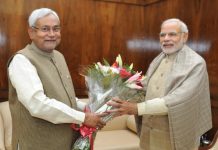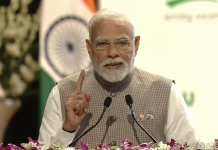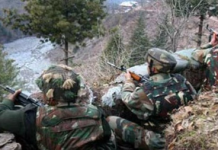Touted to be the world’s largest pilgrimage with over 40 crore devotees, Mahakumbh at Prayagraj showcases a blend of ancient traditions and modern innovations, with UP CM Yogi leveraging the event to bolster cultural nationalism and state’s economic growth. A report by Mudit Mathur
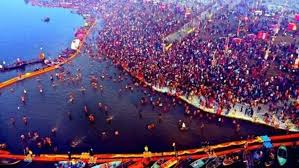
In pursuit of promoting cultural nationalism after the Ram Mandir project at Ayodhya, Uttar Pradesh Chief Minister Yogi Adityanath has once again got an opportunity to showcase himself as a mascot of Hindutva before the largest congregation of pilgrims on earth at ‘Mahakumbh Mela––2025’ in Prayagraj, which is an ancient place of Hindu pilgrimage based on religious mythology. Astrologically, the 45-day-long grandeur ‘Mahakumbh’ which comes after 12 years is going to be repeated after 144 years in the same planetary position. The government has created elaborate lodging and travelling facilities for pilgrims to reach the site.
Amid deep security concerns, Mahakumbh kicked off with the first royal bathing of ‘Makar Sankranti’ on January 14, 2025, and will conclude with the ‘Maha Shivaratri’ bathing on February 26, 2025, showcasing the perfect fusion of faith and modernity leading to the state’s economic prosperity due to the enormous synergy generated through organised saffron efforts. Sprawling over an area of 4,000 hectares along the river bank at the confluence of the Ganga and Yamuna (and the mythical Saraswati) –– according to government estimates, over a 45-day course of religious festivities are expected to attract 400 million visitors from India and abroad.
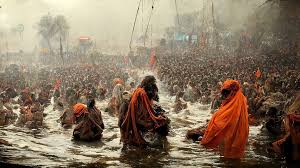
The Yogi government has professionally planned hi-tech Mahakumbh Mela-2025, aimed at fetching big revenues to the state coffers. The state government is expecting an approximate expenditure of Rs 7,500 crore for organising this mega event and has so far has approved Rs 3461.99 crore for financial implementation. In addition, Rs 1636 crore is being allocated to 125 projects through departmental budgets from key departments such as the public works department, housing and urban planning, bridge corporation, tourism, irrigation and the Prayagraj Municipal Corporation.
These projects include infrastructure development, such as the construction and strengthening of roads, railway over-bridges, underpasses, erosion control along river banks, interlocking roadways, riverfront development, and beautification of all major intersections under a hi-tech plan. Prayagraj is also being developed as a top-tier smart city through the coordination of Smart City projects and the Prayagraj Development Authority. IT-based monitoring systems and clean drinking water facilities are being implemented for the benefit of pilgrims. Efforts under the Swachh Bharat Mission and the Prayagraj Municipal Corporation are ensuring advanced sanitation and cleanliness. Solid waste management systems and 100 per cent sewage treatment coverage are also being established.
Uttar Pradesh Chief Minister Yogi Adityanath said, “The Prayagraj Mahakumbh would generate a remarkable estimated revenue of Rs 2 lakh crores to the state’s exchequer drawing economic benefits to such a high value.” “The event will witness the participation of about 40 crore people from across India and abroad that would not only boost Prayagraj’s economy but also make a substantial contribution to the national economic growth.” “Mahakumbh is like ‘Maha Yagya,’ symbolising cultural unity––connecting not only the nation but people from around the world under one spiritual umbrella,” Yogi remarked while addressing the media about the event.
UNESCO recognised Kumbh Mela as an ‘Intangible Cultural Heritage of Humanity.’ Its history dates back thousands of years, right from the era of Adi Shankaracharya. Intangible cultural heritage means the practices, representations, expressions, knowledge, and skills — as well as the instruments, objects, artefacts and cultural spaces associated with them that communities, groups and, in some cases, individuals recognise as a part of their cultural heritage. The grandeur of the cultural extravaganza celebrated in four different cities in India, over a period of 12 years, draws throngs of devotees seeking spirituality and nirvana, bathing in sacred rivers to purify their sins. The festival, held in Prayagraj, Haridwar, Ujjain and Nasik, represents a syncretic set of rituals related to worship in India.
One of the most popular and astonishing mythological stories found in ancient Indian texts is ‘Amrita Manthan’ that is, churning of the ocean for nectar, the celestial water of immortality. It narrates that once the gods and demons agreed to churn the great ocean and share the treasures or the ‘Ratnas’ (Jewels) that will emerge from it. The most precious treasure that emerged was ‘Amrita’, the nectar. Both the gods and the demons laid claims to it. One who drinks it will become immortal and therefore, all-powerful and indestructible. Gods could never accept this. This resulted in a scuffle between them for a pot of nectar (Amrit Kumbh), the nectar of immortality. Lord Vishnu, disguising himself as an enchantress (Mohini), seized the nectar from the demons. While fleeing from the evil ones, Lord Vishnu passed the nectar on to his winged mount, Garuda. The demons finally caught up with Garuda and in the ensuing struggle, a few drops of the precious nectar fell on Prayagraj, Nasik, Haridwar and Ujjain. Since then, the Kumbh Mela has been held in all these places, alternatively, every 12 years.
Prayagraj has been known as the most sacred pilgrimage place for the Hindus, situated at the confluence (Triveni Sangam) of the Ganga, the Yamuna, and the mythical Sarasvati. Hindu saints sporting dreadlocks, smoking chillums (pipes) or practising complex Asanas (poses) used to be common admirable sights for one and all. The whole atmosphere is glittered and charged with chiming bells, incense and flower fragrance scattering flawlessly with the smoke from the ‘Havan Kunds’ (fire spaces), Preaching from saints of different sects of Hinduism, Vedic Hymns, Mantras, Drumbeats, the blast of conches and the ring of holy bells. Apart from bathing rituals, elucidations, traditional dances, devotional songs, programmes based on mythical stories, and prayers are also unique features of this event.
Religious assemblies are held where doctrines are debated, standardized and conducted by renowned saints and sages. An auspicious element of the festival is the act of benevolence to liberally offer donations to the poor, helpless, saints, and to feed or donate cows to priests. Donations range from basic food and clothing to even precious metals. The Kumbh Mela is perhaps the only event in the world where no invitation is required yet millions of pilgrims gather to celebrate the holy event.
Witness the sea of fervent devotees performing their rituals and offering prayers or choose to visit the various Akharas to get a comprehensive view of the ideology and philosophy of different sects of Hinduism. Akharas came into existence during the 8th century AD when Adi Shankaracharya established seven Akhadas namely Mahanirvani, Niranjani, Juna, Atal, Avahan, Agni and Anand Akhara determined to strengthen the Hindu religion and unite those practising different rituals, customs and beliefs. Akharas are divided into different camps according to the concept of God they worship. Shaiva Akharas are for followers of Lord Shiva, Vaishnava or Vairagi Akhara are for followers of Lord Vishnu and Kalpwasis are for followers of Lord Brahma.
All India Radio (AIR) has always played a key role as a public broadcaster, promoting Indian cultural heritage and traditions. AIR launched a special channel ‘Kumbhvani’ which was inaugurated by UP CM Yogi Adityanath on 10th January at Prayagraj. The Union Minister of State for Information and Broadcasting, Dr L. Murugan, joined the occasion through an online platform. Yogi also launched the Kumbh Mangal Dhwani. Prasar Bharati Chairman Dr Navneet Kumar Sehgal, CEO Gaurav Dwivedi, Director-General of All India Radio Dr Pragya Paliwal Gaur, Director-General of Doordarshan Kanchan Prasad, and other senior officials were also present at the function.
The police administration has installed 2,300 CCTV cameras across Prayagraj and the Mahakumbh site to help with population density analysis, crowd control, incident reporting, and cleanliness monitoring through control centres. In the Mela region, authorities have constructed 1.45 lakh restrooms and 99 temporary parking spaces covering 1,850 hectares. Ten digital ‘Khoya-Paya (lost and found) Kendras’ were also formed in the Mahakumbh area as part of efforts to ensure the safety of pilgrims visiting the event.

